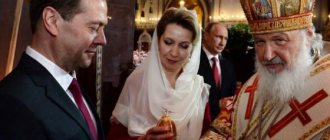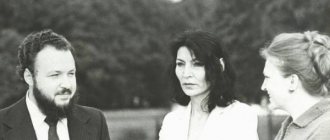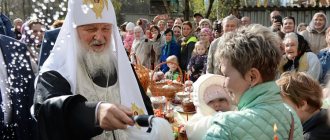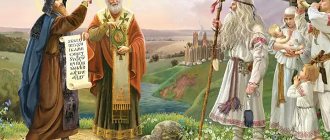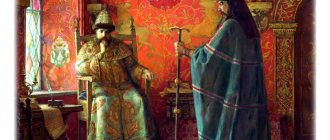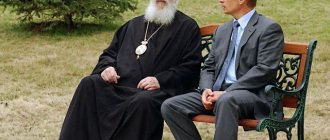The income of Patriarch Kirill is of great interest not only among Orthodox parishioners, but also among people far from the church. There are legends about the fortune of the Patriarch of All Rus'; stories about his earnings and possessions are amazing. It is believed that in the 90s he was directly involved in the organization of the oil, tobacco, food and automobile businesses. Currently, he has at his disposal an apartment in the legendary House on the Embankment, a watch worth about 30,000 euros, luxurious private houses in Gelendzhik and Peredelkino, and even a personal fleet. In this article we will tell you what is known about the business of the head of the Russian Orthodox Church, his place of residence, and the scandals that surrounded him.
Early career
The exact amount of Patriarch Kirill’s income remains unknown. The only thing we can say with certainty is that he is not a poor man. According to expert estimates, Patriarch Kirill's fortune is estimated at several billion dollars.
The hero of our article was born in Leningrad in 1946 into the family of a priest. His father was a priest of the Church of the Smolensk Icon of the Mother of God, and his mother taught German at school. Patriarch Kirill's family consisted of his older brother Nikolai and his younger sister Elena.
After graduating from school, he entered the theological seminary and then the academy. He was tonsured a monk in 1969 under the name Kirill. Since then, Patriarch Kirill’s family has been a church; his life is entirely devoted to serving God.
Bishopric
Kirill's career developed very successfully. Soon after graduating from the academy, he was appointed representative of the Moscow Patriarchate at the World Council of Churches in Geneva. Then he headed the diocesan council of the Leningrad Metropolis and the Theological Academy as rector.
In 1976, in the biography of Vladimir Mikhailovich Gundyaev, that was his name in the world, an important event occurred. He received the rank of bishop, and two years later he ruled the patriarchal parishes in Finland.
In 1984, he was appointed Archbishop of Vyazemsk and Smolensk, and two years later he expanded the parish by including the Kaliningrad region. In 1991 he was elevated to the rank of metropolitan.
During the collapse of the Soviet Union, he took a peacekeeping position, gaining respect among the population. In the 90s in modern Russia, the Moscow Patriarchate began to play an important role in political activity. Kirill was actually the second person after Patriarch Alexy. It is believed that he made a great contribution to the stabilization of relations with the Vatican and reunification with the Russian Orthodox Church.
Patriarchal throne
By the time of Alexy II's death in 2008, Kirill was the most famous Orthodox priest in the country. This was facilitated by the television program “The Word of the Shepherd,” which has been broadcast on Channel One since 1995. He worked closely with the federal government and was the author of the concept in the field of church-state relations.
Kirill was elected Patriarch at the Local Council and received 507 votes out of a possible 677. Kirill remains a patriarch today; in this status, he often makes visits abroad, where he has earned the authority of a person with fundamental knowledge, high intelligence and broad erudition.
He often communicates with Western religious figures; it was under Patriarch Kirill that a historical meeting with the Pope took place. Kirill and Francis talked in February 2021 in the building of the international airport in Cuba.
Age
Many believers are interested in the question, how old is Patriarch Kirill? Everyone knows that the position of Patriarch of Moscow and All Rus' is occupied by clergy who are of advanced age. A person applying for this rank must be a worthy priest and have certain successes. Achieving high results in a priest's career takes a long time. Therefore, all people who assume the honorary position of Patriarch are of advanced age.
At the time of taking office, Patriarch Kirill was 63 years old. Currently 72 years old. He does not follow fashion and innovations, he looks in accordance with his age. With a height of 178 cm, the weight is 92 kg.
House
The main residence where Patriarch Kirill lives is his estate, located in the village of Peredelkino near Moscow. The three-story building is located on a plot of 2.5 hectares. It includes the priest’s personal apartments, hotels, a house church, a health complex, household premises, and a food storage box.
In the house of Patriarch Kirill itself there are luxury interior items that were brought specially from Italy; the facade of the building externally resembles the Terem Palace in the Kremlin.
He has several more residences in Russia. Among the places where Patriarch Kirill lives are mansions in Trinity-Lykovo, on Solovki, on Rublyovka.
In Gelendzhik, in the village of Praskoveevka, construction of a spiritual and educational center began on an area of 16 hectares. Some media reported that this estate will be intended primarily for the patriarch’s summer vacation.
In the 90s, President Boris Yeltsin gave the clergyman a 5-room apartment in the legendary House on the Embankment with a total area of 140 square meters. This is the only real estate that officially belongs to Patriarch Kirill, in the world to Vladimir Gundyaev.
Residence of the Patriarch
The residence of Patriarch Kirill is located at the address: Moscow, Central Administrative District, Khamovniki district, Chisty Lane, building 5. The building is an architectural monument of federal significance. It has a rich and long history. Until the start of the Second World War, the building was intended to house German ambassadors and diplomats. The Patriarchal residence has been located in the building since 1943. The mansion was provided by Joseph Stalin himself. He informed Metropolitans Sergius, Nicholas and Alexy about this during a personal meeting. In addition to the residence, transportation was also provided.
At the end of the 80s, the Patriarchal residence became unfit for use; the building required major repairs. By this time, a new residence had already been built, which was located on the territory of the Danilovsky Monastery. After the renovation was completed, the mansion in Chisty Lane became only the work place of the Patriarchs, a meeting place with journalists and foreign delegations. After the death of Patriarch Alexy, many rooms here were sealed. Currently, the seals have been removed from all premises.
There is another residence of Patriarch Kirill. It is located in Peredelkino. Here he not only works, but also lives.
Car park
Journalists note the priest’s rich and varied fleet of vehicles. Patriarch Kirill’s car, in which he most often travels, is an elongated and armored Mercedes-Benz S-Klasse Pullman.
He also has American SUVs at his disposal - two Cadillacs. However, they are not considered his property, but are registered in the Kremlin’s special-purpose garage.
Kirill often appears on the Chaika with a half-century history.
Creativity and foreign policy activities
In addition to his main Orthodox activities, Patriarch Kirill is actively involved in foreign policy activities. He also became the author of several books written in the religious genre:
- "Belief and Unbelief."
- "Seven words about the Russian world."
- "Thoughts for every day of the year."
- “The mystery of repentance. Lenten Confessions."
- "The Word of the Primate."
In addition to the fact that the Patriarch wrote several books, he became the author of more than 500 religious publications.
The priest takes an active part in various inter-Christian conferences and communicates with representatives of other world religions.
Scandals
The way Patriarch Kirill lives often becomes the cause of indignation among believers, the basis of scandals in the yellow press. The construction of his dacha in Gelendzhik was widely discussed. It all started when activists from an environmental organization entered the territory of the facility under construction and found out that about ten hectares of a unique forest were surrounded by a 3-meter fence. In the very center there was a pretentious building with domes, looking like both a mansion and a temple.
At the same time, according to official information, the Russian Orthodox Church had only two hectares at its disposal. In addition, this land belonged to the Forest Fund, which means that no permanent structures could be erected on it. According to environmentalists, from 5 to 10 hectares of valuable tree species were cut down. This was confirmed by photographs from space. At the same time, Rospotrebnadzor did not detect illegal logging.
The details of how Patriarch Kirill lives often testified to his love for luxury items. According to foreign journalists, his fortune is estimated at four billion dollars. It is not easy to confirm or refute this information, since Patriarch Kirill is not required to file an income statement.
In 2009, the media noticed that the cost of the watch worn by the clergyman was about 30 thousand euros. The scandal erupted when the press service of the Moscow Patriarchate decided to retouch the watch on Kirill’s hand during his meeting with Federal Minister of Justice Alexander Konovalov in 2012. Bloggers noticed that in the photograph posted on the website of the Moscow Patriarchate, the patriarch's watch was covered up in a graphics editor, while its image was preserved in reflection on the table surface.
The scandal surrounding Patriarch Kirill's apartment broke out that same year. The trial for compensation for damage to the living space of the hero of our article caused a public outcry. The defendant was his neighbor, cardiac surgeon Yuri Shevchenko.
It turned out that Lydia Leonova lived in the patriarch’s apartment, who claimed that the dust from Shevchenko’s renovation contained harmful nanoparticles, causing damage not only to the premises of the head of the Russian Orthodox Church, but also to his personal library and unique furniture. The claim was filed for almost 20 million rubles. Both the amount of the claim and the unclear status of Leonova herself drew criticism.
The patriarch himself stated that he had nothing to do with this matter, and Leonova was his second cousin. At the same time, he assured that the money would be used to clean books and charity.
Among believers, the very fact of owning an apartment caused indignation, which contradicts the vow of non-covetousness that every monk takes when taking monastic vows.
The Russian Orthodox Church linked this situation with an organized campaign to discredit the patriarch.
Patriarch of Moscow and All Rus'
Job, elected by the Moscow Council in 1589, became the first Patriarch of Russia, and remained in this position until 1607. The second clergyman to take this place was Hermogenes. The next Russian Patriarchs were Filaret, Nikon, Joseph 1, Adrian.
In 1721, the Holy Synod was created, which abolished the Patriarchate. Instead, a new position was introduced - Guardian of the Patriarchal Throne, which existed until 1917.
In 1917, the All-Russian Local Council restored the Patriarchate. The position was taken by the clergyman Tikhon, who died 8 years later. After which the position of Patriarch was vacant for a long time.
In 1943, the Council of 19 hierarchs chose a new Patriarch. This position was taken by Metropolitan Sergius, who was the only candidate. After his death, the Patriarchs of All Rus' were Alexy, Pimen, Alexy 2.
In 2009, this position was taken by Patriarch Kirill of Moscow.
Tobacco Empire
It is believed that Patriarch Kirill made the basis of his income from a business that he started back in 1993. Then, with the direct participation of the Moscow Patriarchate, the Nika financial and trading group was created. A year later, two commissions for the provision of humanitarian assistance were founded under the federal government. They decided what kind of aid could be exempt from excise taxes and taxes, and it was imported through the church and then sold by commercial structures. Essentially, these were cigarettes that were distributed at market prices through regular retail chains. However, there was no need to pay taxes on them.
About 8 billion cigarettes were imported in 1996 alone. It is believed that then significant damage was caused to the “tobacco kings,” who were forced to pay excise taxes and duties, losing to “church tobacco.”
Patriarch Kirill's current income was largely based on the tobacco business. Experts say that when the priest decided to leave the case, about $50 million worth of cigarettes belonging to the church remained in customs warehouses. It is believed that during the criminal war during the redistribution of the tobacco market, an assistant to deputy Vladimir Zhirinovsky, named Dzen, was killed.
Oil business
Despite the fact that Patriarch Kirill does not officially receive a salary, his fortune is enormous. The oil business also played a certain role in this.
It is known that Kirill was not only related to the Nika Foundation, but was also the founder of the Peresvet commercial bank, the Free People's Television joint-stock company, and the International Economic Cooperation organization.
In 1996, he began exporting oil, and at the request of Alexy II, this business was also exempt from customs duties. The immediate representative of the current patriarch was Bishop Victor (Pyankov). Currently, he permanently resides in America as a private citizen. In 1997 alone, the company's annual turnover was two billion dollars.
It is now unknown whether Kirill continues to participate in this business.
